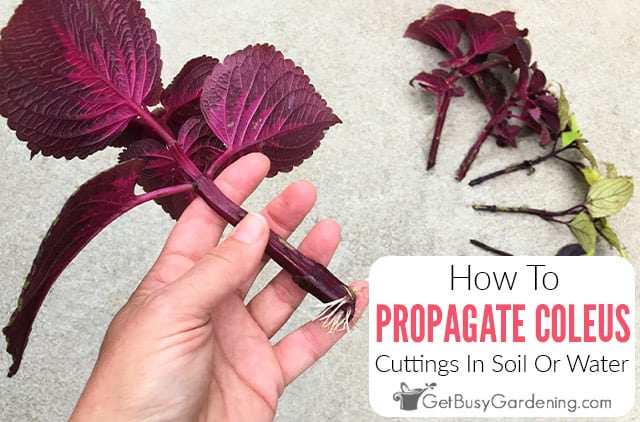To transplant coleus in soil, first prepare the soil by loosening it and adding organic matter. Gently remove the plant from its current container and place it in the new soil, ensuring it’s at the same depth.
Coleus plants are prized for their vibrant foliage and easy care, making them popular choices for gardens and containers. Transplanting these colorful plants into soil allows them to establish strong roots and thrive in their new environment. Whether you’re moving them outdoors or to a larger pot, proper transplantation techniques are vital for their health.

Credit: sowrightseeds.com
This guide will walk you through each step, ensuring your coleus flourishes in its new home. Enjoy the process and watch your coleus bring life to your space!
How to Transplant Coleus in Soil : Step by Step Guide
Introduction To Coleus Transplantation
Coleus plants are known for their vibrant colors and unique leaf shapes. They thrive in various conditions, making them popular among gardeners. Their adaptability allows them to grow in sunny and shady spots.
Proper transplanting techniques are crucial for healthy growth. Ensuring the right soil mix will help the plant establish roots. Watering adequately after transplanting is essential. It helps the plant adjust to its new environment.
Failure to follow these techniques can lead to stunted growth or even plant death. Taking care during transplantation will ensure your Coleus thrives in its new home.
Identifying The Right Time To Transplant
The best season to transplant coleus is in spring. This is when the weather gets warmer. Coleus loves warmth and sunlight. Transplanting in spring helps it grow healthy.
Signs that your coleus is ready for transplant include strong roots. Check if roots are coming out of the pot. Healthy leaves are also a good sign. Look for bright and vibrant colors. A plant that is tall and bushy is ready too.
Transplanting at the right time ensures your coleus thrives. Keep an eye on the weather and plant health.
Selecting The Ideal Soil And Location
Selecting the right soil is crucial for healthy Coleus plants. A well-draining mix is best. Use a mixture of potting soil and perlite for better drainage. Coleus prefers slightly acidic soil with a pH of 6.0 to 6.5.
Pick a spot that receives partial shade to full sun. Too much sun can scorch the leaves. Ensure the location is protected from strong winds.
Regularly check the moisture level in the soil. Coleus likes moist but not soggy soil. Plant them in an area where they can grow freely.
Materials Needed For Transplantation
Transplanting coleus requires a few essential materials. Gather the following tools for a smooth process:
- Garden Trowel: For digging and planting.
- Gloves: Protect your hands while working.
- Watering Can: To water the newly transplanted coleus.
- Fertilizer: Helps the plant grow strong.
- Mulch: Keeps the soil moist and healthy.
Preparing the transplant site is crucial. Choose a spot with good sunlight. Ensure the soil is well-drained. Clear away any weeds or debris. Loosen the soil with a fork or trowel. This helps roots grow easily. Water the area before planting. This makes the soil soft and easy to work with.
Pre-transplant Care For Coleus
Before transplanting coleus, water the plant thoroughly. This helps reduce stress during the move. Ensure the soil is moist but not soggy.
Pruning is important for healthy growth. Trim any dead or damaged leaves. This allows the plant to focus energy on new growth.
Prepare the plant by gently removing it from its pot. Carefully loosen the roots to avoid damage. Place the plant in a new pot for a few hours before planting in soil.
The Step-by-step Transplanting Process
Start by gently digging up the coleus plant. Use a small shovel or trowel. Carefully loosen the soil around the roots. Make sure not to damage the roots while digging.
Once you have the plant out, check for any dead roots. Trim these away using clean scissors. This helps the plant grow better in its new spot.
Next, choose a sunny location for the coleus. It loves bright light but not too much direct sun. Prepare the new spot by loosening the soil. Mix in some compost for nutrients.
Place the coleus in the hole, making sure it sits at the same depth as before. Fill in the hole with soil and pat it down gently. Water the plant well to help it settle.
Post-transplant Care
After transplanting coleus, proper care is essential for healthy growth. Start by watering the plants well. Ensure the soil remains moist but not waterlogged. Overwatering can harm the roots.
Fertilizing helps coleus thrive. Use a balanced fertilizer every four to six weeks. This promotes vibrant foliage and strong roots. Choose a fertilizer with equal parts of nitrogen, phosphorus, and potassium.
Monitoring growth is crucial. Look for signs of stress or wilting. Healthy plants show vibrant colors and sturdy leaves. Check for pests or diseases regularly. Early detection can prevent bigger problems.
Adjust care based on plant needs. Keep an eye on sunlight exposure and soil condition. Changes may be necessary as the plant grows.

Credit: www.youtube.com
Troubleshooting Common Transplant Issues
Transplant shock can happen after moving coleus plants. Signs include wilting and yellowing leaves. To help, keep the soil moist but not soggy. Provide shade for a few days to reduce stress. Gradually reintroduce sunlight. Regularly check for pests.
For pest and disease management, inspect leaves often. Common pests include aphids and spider mites. Use insecticidal soap for control. Fungal diseases can occur in damp conditions. Ensure good air circulation around plants. Remove dead leaves to prevent issues.
Multiplying Your Coleus Collection
To propagate coleus from cuttings, select healthy stems. Cut them just below a leaf node. Place the cuttings in water for a few days. This helps roots develop. Once roots are about 2 inches long, transplant them into soil.
For the best results, use a well-draining potting mix. Water the soil lightly after planting. Ensure the cuttings get enough sunlight, but avoid direct sun.
Sharing and swapping plants with fellow gardeners can be fun. It helps expand your coleus collection. Connect with local gardening groups to find new varieties.
Bring cuttings to share or trade at events. This makes gardening a community activity. Always label your cuttings for better identification.
Conclusion: Enjoying Your Thriving Coleus
Transplanting coleus can be a fun adventure. Watching them grow brings joy. After the transplant, monitor the soil moisture. Keep it slightly damp but not soggy. Healthy plants show vibrant colors and strong leaves.
Reflecting on your transplanting journey is rewarding. Celebrate small victories, like new growth or colorful leaves. Share your experiences with friends and family. They might want to try planting coleus too.
Planning future coleus projects opens many possibilities. Experiment with different colors and sizes. Consider creating a coleus garden or mixing with other plants. Each project helps you learn and grow as a gardener.

Credit: getbusygardening.com
Frequently Asked Questions
How Do You Prepare Soil For Coleus Transplanting?
Preparing soil for coleus transplanting involves ensuring good drainage and fertility. Mix equal parts of potting soil, compost, and perlite. This blend provides essential nutrients while maintaining moisture balance. Make sure the pH is slightly acidic to neutral, ideally between 6.
0 and 7. 0, for optimal growth.
When Is The Best Time To Transplant Coleus?
The best time to transplant coleus is in spring after the last frost. This timing allows the plant to establish roots during warmer weather. Transplanting too early can risk frost damage, while too late may hinder growth. Always check local frost dates for accurate timing.
How Deep Should Coleus Be Planted?
Coleus should be planted at a depth of about 6 to 8 inches. Ensure the root ball is level with the surrounding soil. Planting too deep can suffocate the roots, while too shallow may expose them to the elements. Proper depth promotes healthy growth and stability.
How Often Should You Water Transplanted Coleus?
Transplanted coleus should be watered thoroughly once a week. Ensure the soil stays consistently moist but not soggy. Overwatering can lead to root rot, while underwatering can stress the plant. Adjust your watering frequency based on weather conditions and soil moisture levels.
Conclusion
Successfully transplanting coleus in soil can enhance your garden’s beauty. Following the right steps ensures healthy growth. Remember to choose the right location and care for your plants regularly. With patience and attention, your coleus will thrive, adding vibrant colors to your outdoor space.
Happy gardening!

